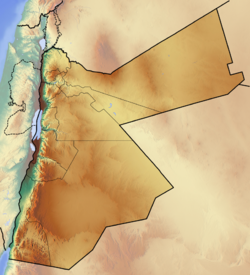Earth:Umm Irna Formation
| Umm Irna Formation Stratigraphic range: Late Permian | |
|---|---|
| Type | Geological formation |
| Underlies | Ma'in Formation |
| Overlies | Unconformity with Umm Ishrin Sandstone |
| Thickness | 60–70 m (200–230 ft) |
| Lithology | |
| Primary | Claystone, siltstone, sandstone |
| Location | |
| Coordinates | [ ⚑ ] : 31°18′N 35°33′E / 31.3°N 35.55°E |
| Country | |
| Extent | Several exposures along the eastern Dead Sea coast |
| Type section | |
| Named by | Bandel & Khoury |
| Location | Wadi Himara |
| Year defined | 1981 |
| Thickness at type section | 63 m (207 ft) |
The Umm Irna Formation is a geological formation in Jordan. It is found in several outcrops in Jordan in the area around the eastern shore of the Dead Sea. It is Late Permian (likely Changhsingian) in age, and is the oldest unit in the succession, overlying the Cambrian aged Umm Ishrin Sandstone Formation. The formation predominantly consists of sandstones, claystones and mudstones deposited in fluvial and lacustrine conditions.[1] The formation is of considerable paleobotanical interest, as it preserves the earliest known remains of plant groups that would become widespread during the Mesozoic, including corystosperm "seed ferns", represented by the widespread Triassic genus Dicroidium, cycads (cf. Ctenis), conifers (which were originally suggested to be podocarps, but this was later questioned[2]), as well as Bennettitales.[3] Other plant groups present in the formation include Noeggerathiales, gigantopterids, lyginopterids and possible ginkgophytes.[3][4]
References
- ↑ Stephenson, Michael H.; Powell, John H. (2013-07-01). "Palynology and alluvial architecture in the Permian Umm Irna Formation, Dead Sea, Jordan" (in en). GeoArabia 18 (3): 17–60. doi:10.2113/geoarabia180317. ISSN 1025-6059. Bibcode: 2013GeoAr..18...17S.
- ↑ Andruchow-Colombo, Ana; Escapa, Ignacio H; Aagesen, Lone; Matsunaga, Kelly K S (2023-08-04). "In search of lost time: tracing the fossil diversity of Podocarpaceae through the ages" (in en). Botanical Journal of the Linnean Society. doi:10.1093/botlinnean/boad027. ISSN 0024-4074. https://academic.oup.com/botlinnean/advance-article/doi/10.1093/botlinnean/boad027/7237351.
- ↑ 3.0 3.1 Blomenkemper, Patrick; Kerp, Hans; Hamad, Abdalla Abu; DiMichele, William A.; Bomfleur, Benjamin (2018-12-21). "A hidden cradle of plant evolution in Permian tropical lowlands" (in en). Science 362 (6421): 1414–1416. doi:10.1126/science.aau4061. ISSN 0036-8075. PMID 30573628. Bibcode: 2018Sci...362.1414B.
- ↑ Zavialova, Natalia; Blomenkemper, Patrick; Kerp, Hans; Hamad, Abdalla Abu; Bomfleur, Benjamin (2021-03-04). "A lyginopterid pollen organ from the upper Permian of the Dead Sea region" (in en). Grana 60 (2): 81–96. doi:10.1080/00173134.2020.1772360. ISSN 0017-3134. https://www.tandfonline.com/doi/full/10.1080/00173134.2020.1772360.
 |


